Analysis of the Effects of Texting on Driving and Road Safety
VerifiedAdded on 2023/06/03
|8
|2328
|237
Essay
AI Summary
This essay delves into the significant dangers associated with texting while driving, highlighting its detrimental effects on road safety. The paper emphasizes how texting diverts drivers' attention from the road, leading to increased risks of accidents and fatalities. It presents statistical data from sources like the CDC and Virginia Tech Transportation Institute to underscore the severity of the issue, including the impact on eye movements, reaction times, and overall driving performance. The essay discusses the psychological aspects of this behavior, citing research on multitasking and addiction, and suggests practical solutions such as turning off cell phones, utilizing disabling applications, and raising public awareness through educational programs. The conclusion stresses the necessity of combined efforts from legislation, technology, social media, and individual responsibility to prevent injuries and deaths caused by distracted driving.

Running head: EFFECTS OF TEXTING ON DRIVING
EFFECTS OF TEXTING ON DRIVING
Name of the Student:
Name of the University:
Author note:
EFFECTS OF TEXTING ON DRIVING
Name of the Student:
Name of the University:
Author note:
Paraphrase This Document
Need a fresh take? Get an instant paraphrase of this document with our AI Paraphraser
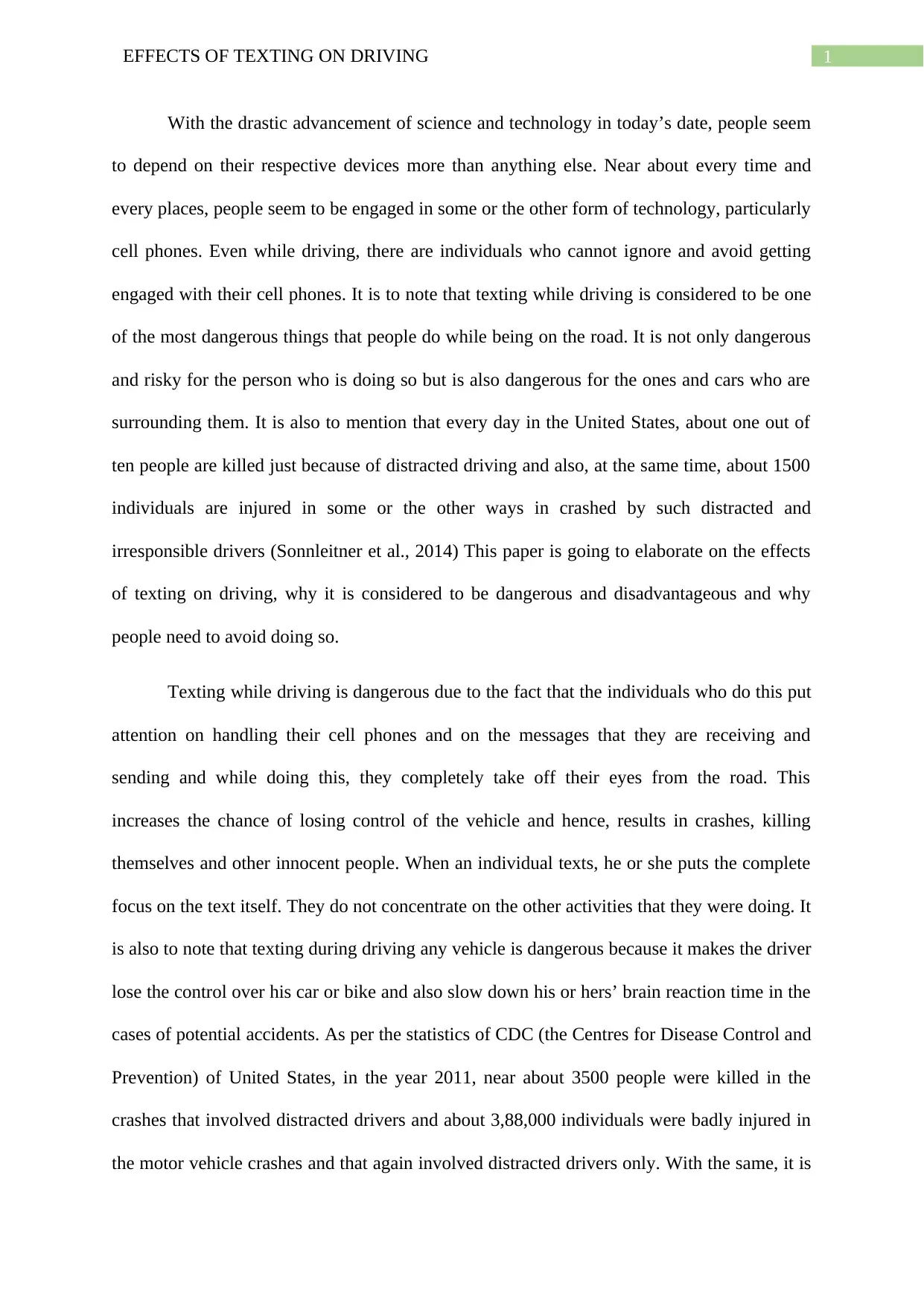
1EFFECTS OF TEXTING ON DRIVING
With the drastic advancement of science and technology in today’s date, people seem
to depend on their respective devices more than anything else. Near about every time and
every places, people seem to be engaged in some or the other form of technology, particularly
cell phones. Even while driving, there are individuals who cannot ignore and avoid getting
engaged with their cell phones. It is to note that texting while driving is considered to be one
of the most dangerous things that people do while being on the road. It is not only dangerous
and risky for the person who is doing so but is also dangerous for the ones and cars who are
surrounding them. It is also to mention that every day in the United States, about one out of
ten people are killed just because of distracted driving and also, at the same time, about 1500
individuals are injured in some or the other ways in crashed by such distracted and
irresponsible drivers (Sonnleitner et al., 2014) This paper is going to elaborate on the effects
of texting on driving, why it is considered to be dangerous and disadvantageous and why
people need to avoid doing so.
Texting while driving is dangerous due to the fact that the individuals who do this put
attention on handling their cell phones and on the messages that they are receiving and
sending and while doing this, they completely take off their eyes from the road. This
increases the chance of losing control of the vehicle and hence, results in crashes, killing
themselves and other innocent people. When an individual texts, he or she puts the complete
focus on the text itself. They do not concentrate on the other activities that they were doing. It
is also to note that texting during driving any vehicle is dangerous because it makes the driver
lose the control over his car or bike and also slow down his or hers’ brain reaction time in the
cases of potential accidents. As per the statistics of CDC (the Centres for Disease Control and
Prevention) of United States, in the year 2011, near about 3500 people were killed in the
crashes that involved distracted drivers and about 3,88,000 individuals were badly injured in
the motor vehicle crashes and that again involved distracted drivers only. With the same, it is
With the drastic advancement of science and technology in today’s date, people seem
to depend on their respective devices more than anything else. Near about every time and
every places, people seem to be engaged in some or the other form of technology, particularly
cell phones. Even while driving, there are individuals who cannot ignore and avoid getting
engaged with their cell phones. It is to note that texting while driving is considered to be one
of the most dangerous things that people do while being on the road. It is not only dangerous
and risky for the person who is doing so but is also dangerous for the ones and cars who are
surrounding them. It is also to mention that every day in the United States, about one out of
ten people are killed just because of distracted driving and also, at the same time, about 1500
individuals are injured in some or the other ways in crashed by such distracted and
irresponsible drivers (Sonnleitner et al., 2014) This paper is going to elaborate on the effects
of texting on driving, why it is considered to be dangerous and disadvantageous and why
people need to avoid doing so.
Texting while driving is dangerous due to the fact that the individuals who do this put
attention on handling their cell phones and on the messages that they are receiving and
sending and while doing this, they completely take off their eyes from the road. This
increases the chance of losing control of the vehicle and hence, results in crashes, killing
themselves and other innocent people. When an individual texts, he or she puts the complete
focus on the text itself. They do not concentrate on the other activities that they were doing. It
is also to note that texting during driving any vehicle is dangerous because it makes the driver
lose the control over his car or bike and also slow down his or hers’ brain reaction time in the
cases of potential accidents. As per the statistics of CDC (the Centres for Disease Control and
Prevention) of United States, in the year 2011, near about 3500 people were killed in the
crashes that involved distracted drivers and about 3,88,000 individuals were badly injured in
the motor vehicle crashes and that again involved distracted drivers only. With the same, it is
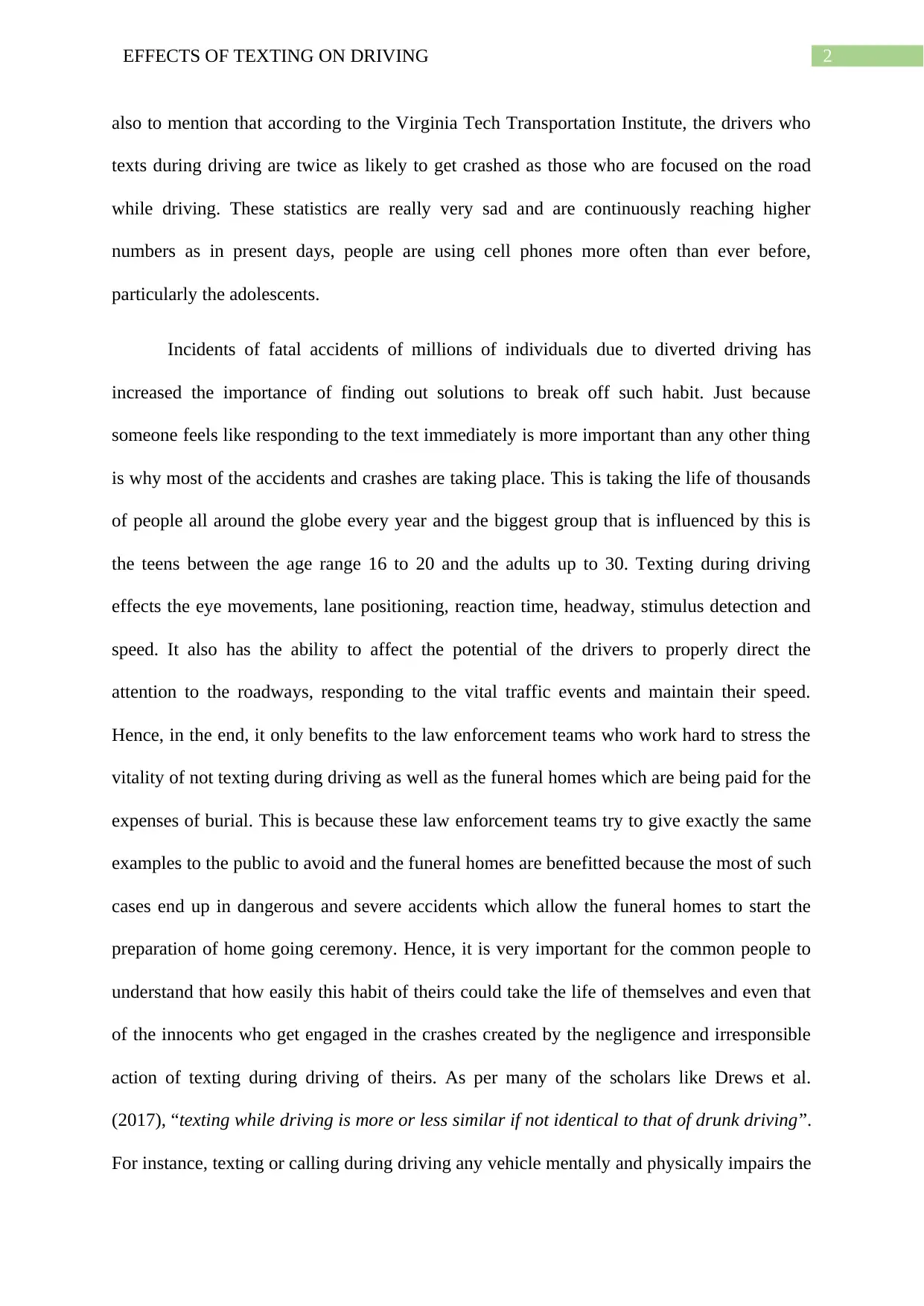
2EFFECTS OF TEXTING ON DRIVING
also to mention that according to the Virginia Tech Transportation Institute, the drivers who
texts during driving are twice as likely to get crashed as those who are focused on the road
while driving. These statistics are really very sad and are continuously reaching higher
numbers as in present days, people are using cell phones more often than ever before,
particularly the adolescents.
Incidents of fatal accidents of millions of individuals due to diverted driving has
increased the importance of finding out solutions to break off such habit. Just because
someone feels like responding to the text immediately is more important than any other thing
is why most of the accidents and crashes are taking place. This is taking the life of thousands
of people all around the globe every year and the biggest group that is influenced by this is
the teens between the age range 16 to 20 and the adults up to 30. Texting during driving
effects the eye movements, lane positioning, reaction time, headway, stimulus detection and
speed. It also has the ability to affect the potential of the drivers to properly direct the
attention to the roadways, responding to the vital traffic events and maintain their speed.
Hence, in the end, it only benefits to the law enforcement teams who work hard to stress the
vitality of not texting during driving as well as the funeral homes which are being paid for the
expenses of burial. This is because these law enforcement teams try to give exactly the same
examples to the public to avoid and the funeral homes are benefitted because the most of such
cases end up in dangerous and severe accidents which allow the funeral homes to start the
preparation of home going ceremony. Hence, it is very important for the common people to
understand that how easily this habit of theirs could take the life of themselves and even that
of the innocents who get engaged in the crashes created by the negligence and irresponsible
action of texting during driving of theirs. As per many of the scholars like Drews et al.
(2017), “texting while driving is more or less similar if not identical to that of drunk driving”.
For instance, texting or calling during driving any vehicle mentally and physically impairs the
also to mention that according to the Virginia Tech Transportation Institute, the drivers who
texts during driving are twice as likely to get crashed as those who are focused on the road
while driving. These statistics are really very sad and are continuously reaching higher
numbers as in present days, people are using cell phones more often than ever before,
particularly the adolescents.
Incidents of fatal accidents of millions of individuals due to diverted driving has
increased the importance of finding out solutions to break off such habit. Just because
someone feels like responding to the text immediately is more important than any other thing
is why most of the accidents and crashes are taking place. This is taking the life of thousands
of people all around the globe every year and the biggest group that is influenced by this is
the teens between the age range 16 to 20 and the adults up to 30. Texting during driving
effects the eye movements, lane positioning, reaction time, headway, stimulus detection and
speed. It also has the ability to affect the potential of the drivers to properly direct the
attention to the roadways, responding to the vital traffic events and maintain their speed.
Hence, in the end, it only benefits to the law enforcement teams who work hard to stress the
vitality of not texting during driving as well as the funeral homes which are being paid for the
expenses of burial. This is because these law enforcement teams try to give exactly the same
examples to the public to avoid and the funeral homes are benefitted because the most of such
cases end up in dangerous and severe accidents which allow the funeral homes to start the
preparation of home going ceremony. Hence, it is very important for the common people to
understand that how easily this habit of theirs could take the life of themselves and even that
of the innocents who get engaged in the crashes created by the negligence and irresponsible
action of texting during driving of theirs. As per many of the scholars like Drews et al.
(2017), “texting while driving is more or less similar if not identical to that of drunk driving”.
For instance, texting or calling during driving any vehicle mentally and physically impairs the
⊘ This is a preview!⊘
Do you want full access?
Subscribe today to unlock all pages.

Trusted by 1+ million students worldwide
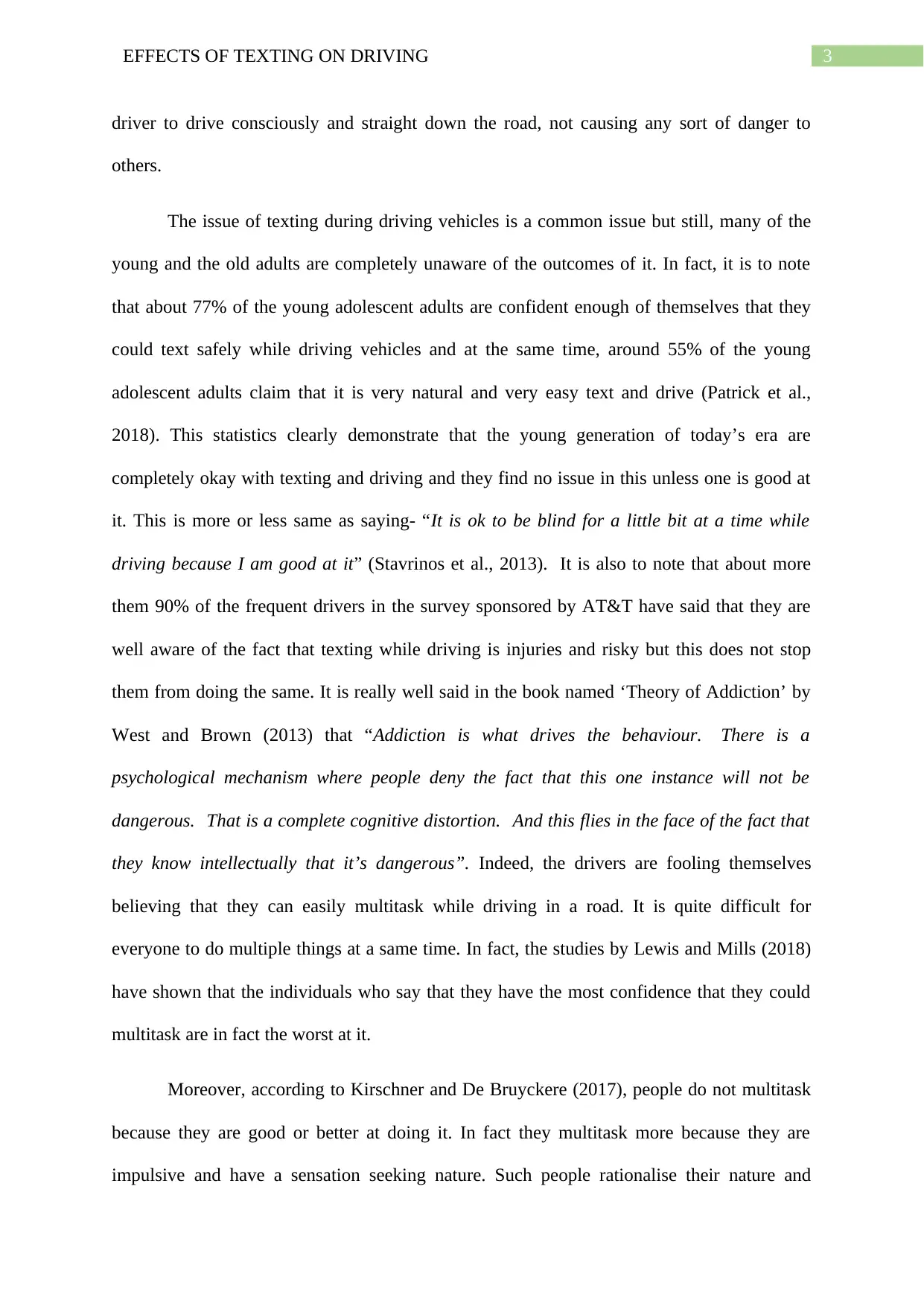
3EFFECTS OF TEXTING ON DRIVING
driver to drive consciously and straight down the road, not causing any sort of danger to
others.
The issue of texting during driving vehicles is a common issue but still, many of the
young and the old adults are completely unaware of the outcomes of it. In fact, it is to note
that about 77% of the young adolescent adults are confident enough of themselves that they
could text safely while driving vehicles and at the same time, around 55% of the young
adolescent adults claim that it is very natural and very easy text and drive (Patrick et al.,
2018). This statistics clearly demonstrate that the young generation of today’s era are
completely okay with texting and driving and they find no issue in this unless one is good at
it. This is more or less same as saying- “It is ok to be blind for a little bit at a time while
driving because I am good at it” (Stavrinos et al., 2013). It is also to note that about more
them 90% of the frequent drivers in the survey sponsored by AT&T have said that they are
well aware of the fact that texting while driving is injuries and risky but this does not stop
them from doing the same. It is really well said in the book named ‘Theory of Addiction’ by
West and Brown (2013) that “Addiction is what drives the behaviour. There is a
psychological mechanism where people deny the fact that this one instance will not be
dangerous. That is a complete cognitive distortion. And this flies in the face of the fact that
they know intellectually that it’s dangerous”. Indeed, the drivers are fooling themselves
believing that they can easily multitask while driving in a road. It is quite difficult for
everyone to do multiple things at a same time. In fact, the studies by Lewis and Mills (2018)
have shown that the individuals who say that they have the most confidence that they could
multitask are in fact the worst at it.
Moreover, according to Kirschner and De Bruyckere (2017), people do not multitask
because they are good or better at doing it. In fact they multitask more because they are
impulsive and have a sensation seeking nature. Such people rationalise their nature and
driver to drive consciously and straight down the road, not causing any sort of danger to
others.
The issue of texting during driving vehicles is a common issue but still, many of the
young and the old adults are completely unaware of the outcomes of it. In fact, it is to note
that about 77% of the young adolescent adults are confident enough of themselves that they
could text safely while driving vehicles and at the same time, around 55% of the young
adolescent adults claim that it is very natural and very easy text and drive (Patrick et al.,
2018). This statistics clearly demonstrate that the young generation of today’s era are
completely okay with texting and driving and they find no issue in this unless one is good at
it. This is more or less same as saying- “It is ok to be blind for a little bit at a time while
driving because I am good at it” (Stavrinos et al., 2013). It is also to note that about more
them 90% of the frequent drivers in the survey sponsored by AT&T have said that they are
well aware of the fact that texting while driving is injuries and risky but this does not stop
them from doing the same. It is really well said in the book named ‘Theory of Addiction’ by
West and Brown (2013) that “Addiction is what drives the behaviour. There is a
psychological mechanism where people deny the fact that this one instance will not be
dangerous. That is a complete cognitive distortion. And this flies in the face of the fact that
they know intellectually that it’s dangerous”. Indeed, the drivers are fooling themselves
believing that they can easily multitask while driving in a road. It is quite difficult for
everyone to do multiple things at a same time. In fact, the studies by Lewis and Mills (2018)
have shown that the individuals who say that they have the most confidence that they could
multitask are in fact the worst at it.
Moreover, according to Kirschner and De Bruyckere (2017), people do not multitask
because they are good or better at doing it. In fact they multitask more because they are
impulsive and have a sensation seeking nature. Such people rationalise their nature and
Paraphrase This Document
Need a fresh take? Get an instant paraphrase of this document with our AI Paraphraser
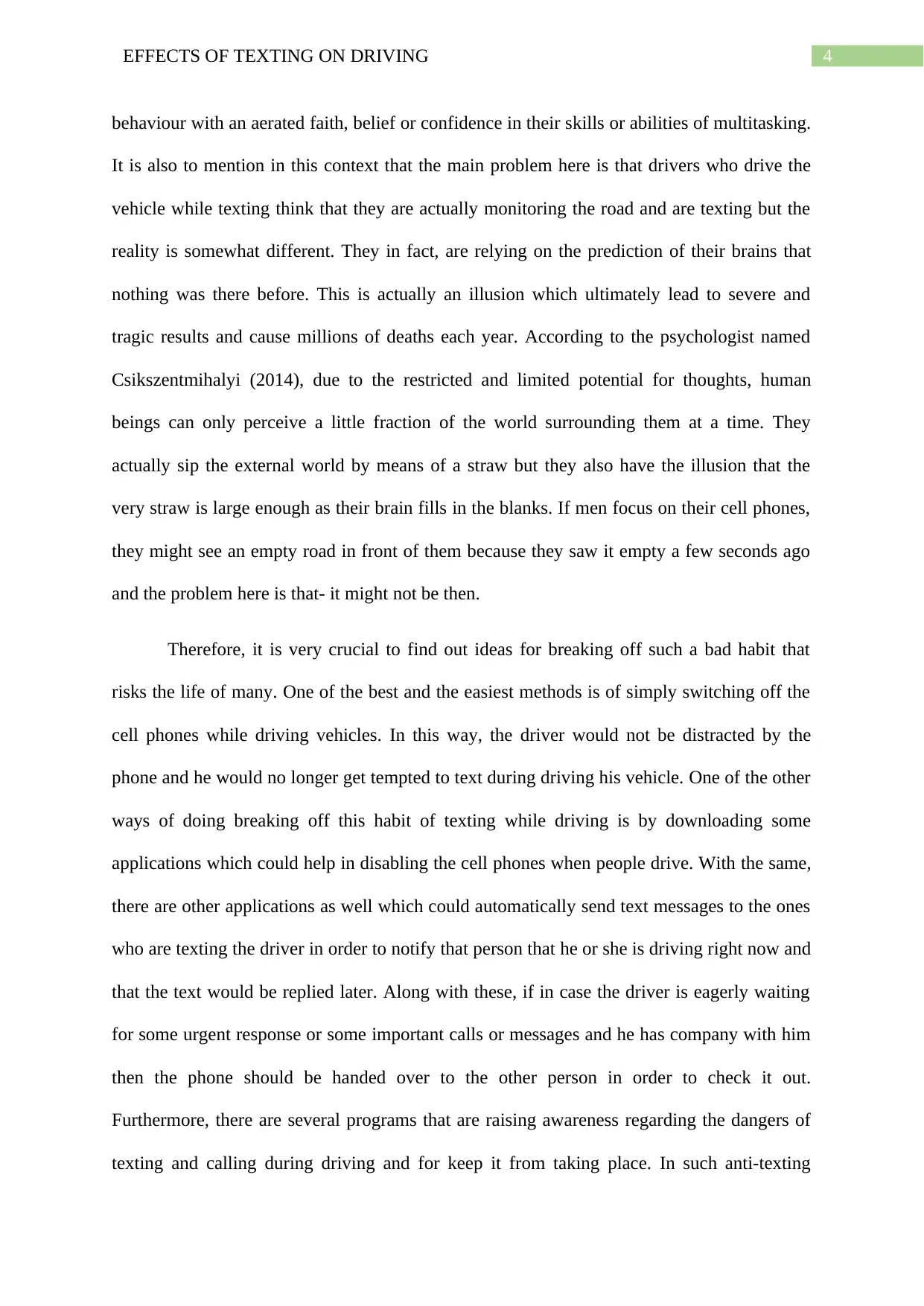
4EFFECTS OF TEXTING ON DRIVING
behaviour with an aerated faith, belief or confidence in their skills or abilities of multitasking.
It is also to mention in this context that the main problem here is that drivers who drive the
vehicle while texting think that they are actually monitoring the road and are texting but the
reality is somewhat different. They in fact, are relying on the prediction of their brains that
nothing was there before. This is actually an illusion which ultimately lead to severe and
tragic results and cause millions of deaths each year. According to the psychologist named
Csikszentmihalyi (2014), due to the restricted and limited potential for thoughts, human
beings can only perceive a little fraction of the world surrounding them at a time. They
actually sip the external world by means of a straw but they also have the illusion that the
very straw is large enough as their brain fills in the blanks. If men focus on their cell phones,
they might see an empty road in front of them because they saw it empty a few seconds ago
and the problem here is that- it might not be then.
Therefore, it is very crucial to find out ideas for breaking off such a bad habit that
risks the life of many. One of the best and the easiest methods is of simply switching off the
cell phones while driving vehicles. In this way, the driver would not be distracted by the
phone and he would no longer get tempted to text during driving his vehicle. One of the other
ways of doing breaking off this habit of texting while driving is by downloading some
applications which could help in disabling the cell phones when people drive. With the same,
there are other applications as well which could automatically send text messages to the ones
who are texting the driver in order to notify that person that he or she is driving right now and
that the text would be replied later. Along with these, if in case the driver is eagerly waiting
for some urgent response or some important calls or messages and he has company with him
then the phone should be handed over to the other person in order to check it out.
Furthermore, there are several programs that are raising awareness regarding the dangers of
texting and calling during driving and for keep it from taking place. In such anti-texting
behaviour with an aerated faith, belief or confidence in their skills or abilities of multitasking.
It is also to mention in this context that the main problem here is that drivers who drive the
vehicle while texting think that they are actually monitoring the road and are texting but the
reality is somewhat different. They in fact, are relying on the prediction of their brains that
nothing was there before. This is actually an illusion which ultimately lead to severe and
tragic results and cause millions of deaths each year. According to the psychologist named
Csikszentmihalyi (2014), due to the restricted and limited potential for thoughts, human
beings can only perceive a little fraction of the world surrounding them at a time. They
actually sip the external world by means of a straw but they also have the illusion that the
very straw is large enough as their brain fills in the blanks. If men focus on their cell phones,
they might see an empty road in front of them because they saw it empty a few seconds ago
and the problem here is that- it might not be then.
Therefore, it is very crucial to find out ideas for breaking off such a bad habit that
risks the life of many. One of the best and the easiest methods is of simply switching off the
cell phones while driving vehicles. In this way, the driver would not be distracted by the
phone and he would no longer get tempted to text during driving his vehicle. One of the other
ways of doing breaking off this habit of texting while driving is by downloading some
applications which could help in disabling the cell phones when people drive. With the same,
there are other applications as well which could automatically send text messages to the ones
who are texting the driver in order to notify that person that he or she is driving right now and
that the text would be replied later. Along with these, if in case the driver is eagerly waiting
for some urgent response or some important calls or messages and he has company with him
then the phone should be handed over to the other person in order to check it out.
Furthermore, there are several programs that are raising awareness regarding the dangers of
texting and calling during driving and for keep it from taking place. In such anti-texting
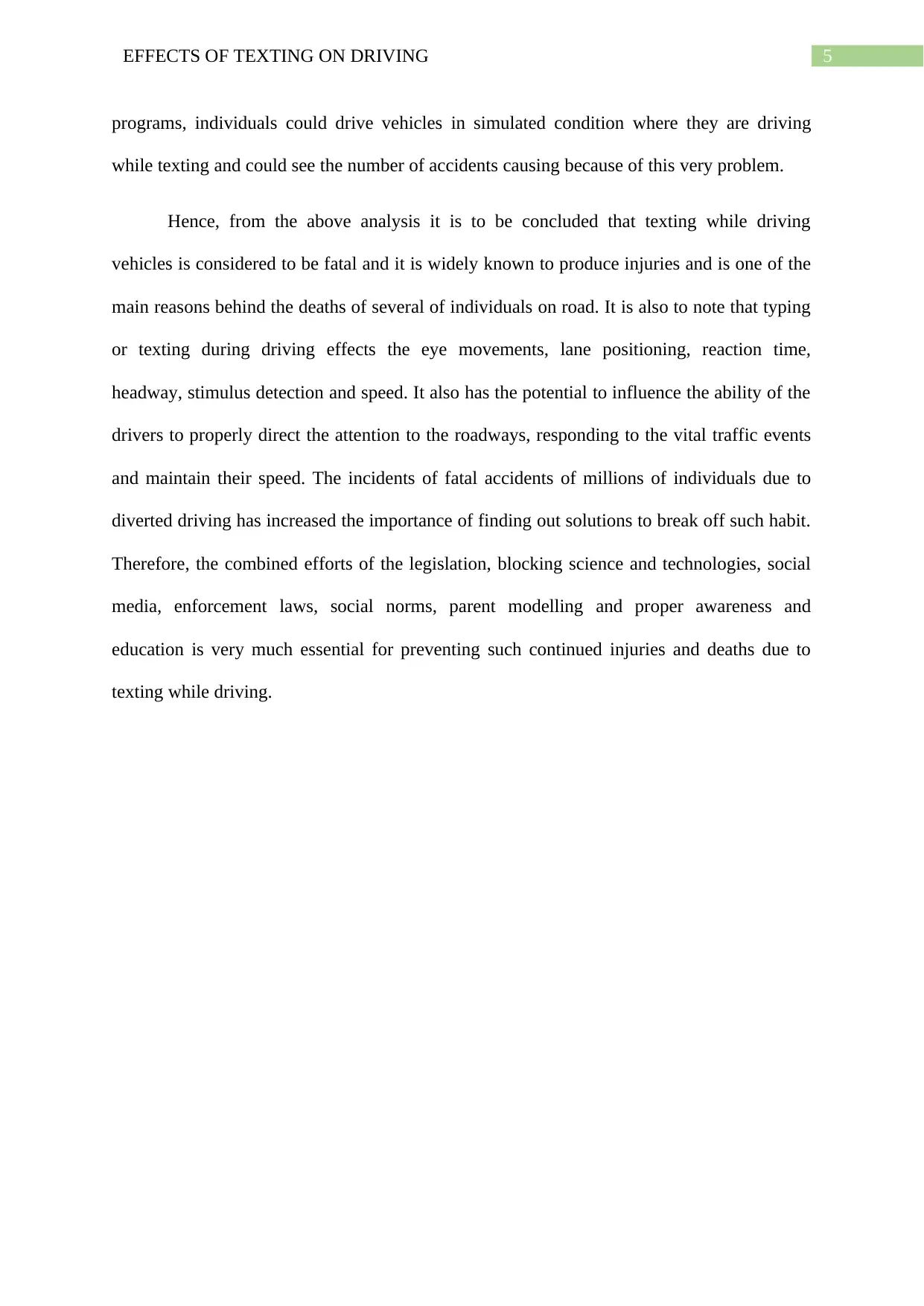
5EFFECTS OF TEXTING ON DRIVING
programs, individuals could drive vehicles in simulated condition where they are driving
while texting and could see the number of accidents causing because of this very problem.
Hence, from the above analysis it is to be concluded that texting while driving
vehicles is considered to be fatal and it is widely known to produce injuries and is one of the
main reasons behind the deaths of several of individuals on road. It is also to note that typing
or texting during driving effects the eye movements, lane positioning, reaction time,
headway, stimulus detection and speed. It also has the potential to influence the ability of the
drivers to properly direct the attention to the roadways, responding to the vital traffic events
and maintain their speed. The incidents of fatal accidents of millions of individuals due to
diverted driving has increased the importance of finding out solutions to break off such habit.
Therefore, the combined efforts of the legislation, blocking science and technologies, social
media, enforcement laws, social norms, parent modelling and proper awareness and
education is very much essential for preventing such continued injuries and deaths due to
texting while driving.
programs, individuals could drive vehicles in simulated condition where they are driving
while texting and could see the number of accidents causing because of this very problem.
Hence, from the above analysis it is to be concluded that texting while driving
vehicles is considered to be fatal and it is widely known to produce injuries and is one of the
main reasons behind the deaths of several of individuals on road. It is also to note that typing
or texting during driving effects the eye movements, lane positioning, reaction time,
headway, stimulus detection and speed. It also has the potential to influence the ability of the
drivers to properly direct the attention to the roadways, responding to the vital traffic events
and maintain their speed. The incidents of fatal accidents of millions of individuals due to
diverted driving has increased the importance of finding out solutions to break off such habit.
Therefore, the combined efforts of the legislation, blocking science and technologies, social
media, enforcement laws, social norms, parent modelling and proper awareness and
education is very much essential for preventing such continued injuries and deaths due to
texting while driving.
⊘ This is a preview!⊘
Do you want full access?
Subscribe today to unlock all pages.

Trusted by 1+ million students worldwide

6EFFECTS OF TEXTING ON DRIVING
References:
Csikszentmihalyi, M. (2014). Toward a psychology of optimal experience. In Flow and the
foundations of positive psychology (pp. 209-226). Springer, Dordrecht.
Drews, F. A., Yazdani, H., Godfrey, C. N., Cooper, J. M., & Strayer, D. L. (2017). Text
messaging during simulated driving. Human factors, 51(5), 762-770.
Kirschner, P. A., & De Bruyckere, P. (2017). The myths of the digital native and the
multitasker. Teaching and Teacher Education, 67, 135-142.
Lewis, D., & Mills, G. R. (2018). The Bullseye Principle: Mastering Intention-based
Communication to Collaborate, Execute, and Succeed. John Wiley & Sons.
Patrick, K. E., Hurewitz, F., McCurdy, M. D., Agate, F. T., Daly, B. P., Tarazi, R. A., ... &
Schultheis, M. T. (2018). Driving comparisons between young adults with autism
spectrum disorder and typical development. Journal of Developmental & Behavioral
Pediatrics, 39(6), 451-460.
Sonnleitner, A., Treder, M. S., Simon, M., Willmann, S., Ewald, A., Buchner, A., & Schrauf,
M. (2014). EEG alpha spindles and prolonged brake reaction times during auditory
distraction in an on-road driving study. Accident Analysis & Prevention, 62, 110-118.
Stavrinos, D., Jones, J. L., Garner, A. A., Griffin, R., Franklin, C. A., Ball, D., ... & Fine, P.
R. (2013). Impact of distracted driving on safety and traffic flow. Accident Analysis &
Prevention, 61, 63-70.
References:
Csikszentmihalyi, M. (2014). Toward a psychology of optimal experience. In Flow and the
foundations of positive psychology (pp. 209-226). Springer, Dordrecht.
Drews, F. A., Yazdani, H., Godfrey, C. N., Cooper, J. M., & Strayer, D. L. (2017). Text
messaging during simulated driving. Human factors, 51(5), 762-770.
Kirschner, P. A., & De Bruyckere, P. (2017). The myths of the digital native and the
multitasker. Teaching and Teacher Education, 67, 135-142.
Lewis, D., & Mills, G. R. (2018). The Bullseye Principle: Mastering Intention-based
Communication to Collaborate, Execute, and Succeed. John Wiley & Sons.
Patrick, K. E., Hurewitz, F., McCurdy, M. D., Agate, F. T., Daly, B. P., Tarazi, R. A., ... &
Schultheis, M. T. (2018). Driving comparisons between young adults with autism
spectrum disorder and typical development. Journal of Developmental & Behavioral
Pediatrics, 39(6), 451-460.
Sonnleitner, A., Treder, M. S., Simon, M., Willmann, S., Ewald, A., Buchner, A., & Schrauf,
M. (2014). EEG alpha spindles and prolonged brake reaction times during auditory
distraction in an on-road driving study. Accident Analysis & Prevention, 62, 110-118.
Stavrinos, D., Jones, J. L., Garner, A. A., Griffin, R., Franklin, C. A., Ball, D., ... & Fine, P.
R. (2013). Impact of distracted driving on safety and traffic flow. Accident Analysis &
Prevention, 61, 63-70.
Paraphrase This Document
Need a fresh take? Get an instant paraphrase of this document with our AI Paraphraser

7EFFECTS OF TEXTING ON DRIVING
West, R., & Brown, J. (2013). Theory of addiction. John Wiley & Sons.
West, R., & Brown, J. (2013). Theory of addiction. John Wiley & Sons.
1 out of 8
Related Documents
Your All-in-One AI-Powered Toolkit for Academic Success.
+13062052269
info@desklib.com
Available 24*7 on WhatsApp / Email
![[object Object]](/_next/static/media/star-bottom.7253800d.svg)
Unlock your academic potential
Copyright © 2020–2025 A2Z Services. All Rights Reserved. Developed and managed by ZUCOL.





